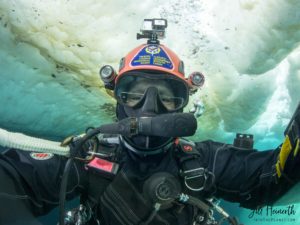 Reliable drysuits are critical for survival and comfort in cold water. Without proper exposure protection, one could expect to survive for less than 45 minutes in water that is near freezing. In less than 15 minutes, unconsciousness would be likely.
Reliable drysuits are critical for survival and comfort in cold water. Without proper exposure protection, one could expect to survive for less than 45 minutes in water that is near freezing. In less than 15 minutes, unconsciousness would be likely.
The best drysuits are custom-tailored and manufactured with custom features. When wearing heavy layers, you still need good range of motion. A drysuit should be light and soft but also durable and flexible. A cold-water hood should be made with supple, stretchy neoprene that seals well on the face. Undergarments must be of a technical variety that will retain insulation properties even if wet. Base layers of merino wool or Capilene are moisture-wicking, warm, and odor-resistant. Most cold-water divers wear dry gloves that dock to rings on the wrist. Neoprene wet gloves can be used if they are thick. Most neoprene gloves are of a three-finger variety for warmth, so you will need to practice your dexterity.
Heated undergarments and heated gloves are another option for increasing your comfort. The wiring for heated undergarments is ported through the drysuit inflation valve, which is replaced with a dual-purpose Thermo valve. An E/O connector hanging from the chest plugs into a lithium-ion battery pack on the diver’s waist. These specially designed battery packs are intended to provide up to two hours of warmth on full power. Electric undergarments demand high-amperage, and therefore high capacity lithium batteries. Systems designed for topside use such as motorcycle and hunting products are not suitable for diving. They can short, causing burns, electrical shock, and even fire.
Some dive shops rent drysuits. Since fit is important, be sure to try it out in a pool and take a Drysuit Specialty class or orientation before jumping into cold water. Polar regions are not a good place to try new gear or new techniques for the first time. By preparing your equipment and sharpening your skills before a trip, you will get the most out of enjoying the remarkable sights of the Arctic.
